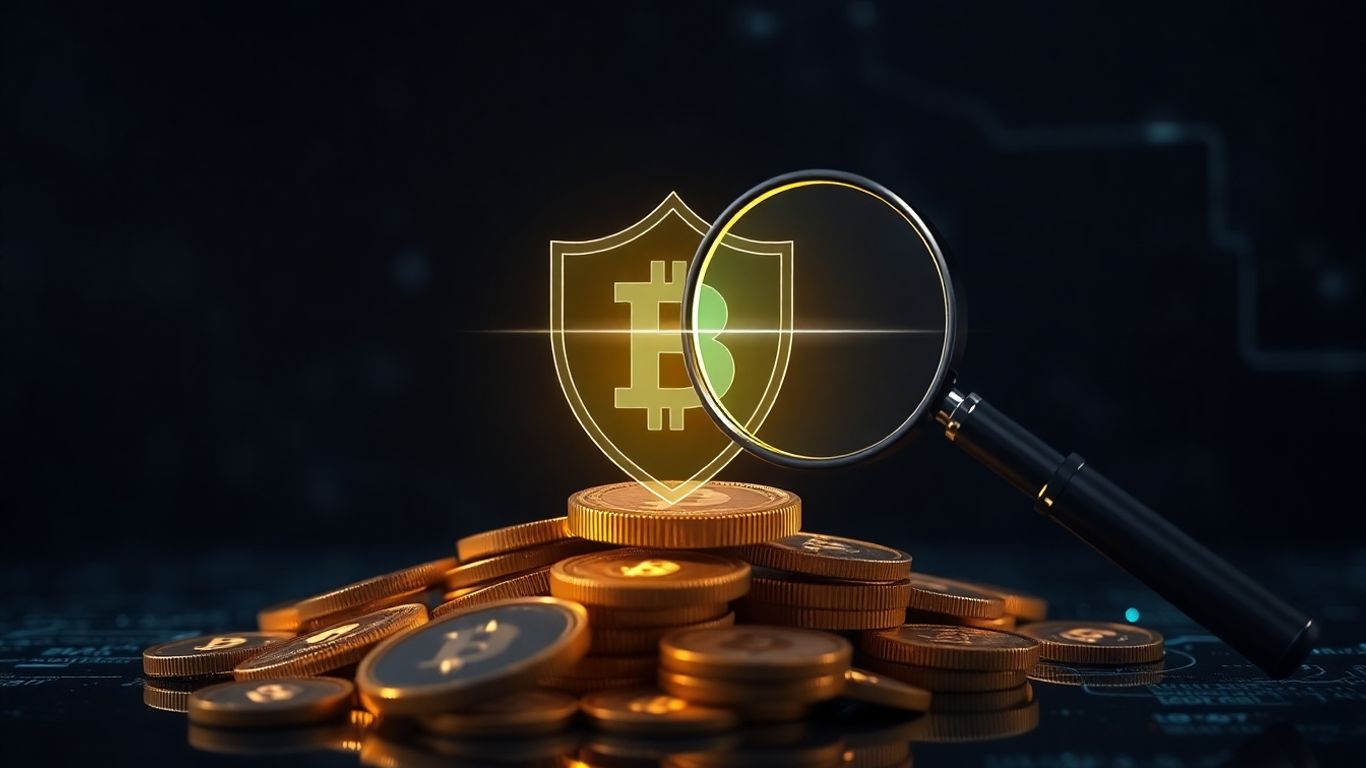[ newsletter ]
Stay ahead of Web3 threats—subscribe to our newsletter for the latest in blockchain security insights and updates.
Thank you! Your submission has been received!
Oops! Something went wrong. Please try again.
Master crypto incident response from triage to recovery. Learn strategies for containment, forensics, mitigation, and post-incident analysis.





Dealing with security issues in the crypto world can be pretty wild. Things move fast, and when something goes wrong, it feels like a fire drill. Whether it's a hack or a scam, knowing what to do when trouble hits is super important. This guide breaks down how to handle these situations, from the first sign of trouble all the way to getting things back to normal. It’s all about being ready and knowing the steps for effective incident response crypto.

The world of cryptocurrency is exciting, but it also comes with its own set of risks. When things go wrong, like a hack or a major exploit, knowing how to react is super important. This isn't like dealing with a regular website glitch; crypto incidents can involve stolen funds, broken smart contracts, and complex on-chain activity. A well-prepared incident response plan is your best defense against significant financial and reputational damage.
The ways attackers try to steal crypto are always changing. We're seeing more sophisticated attacks targeting decentralized finance (DeFi) protocols, which unfortunately accounted for a huge chunk of stolen funds in recent years. Hackers are getting smarter, using things like flash loans to manipulate markets, exploiting smart contract logic errors, and even using social engineering to trick people. It's a constant cat-and-mouse game.
Here's a look at some common attack vectors:
Web3 security presents unique hurdles. For starters, the decentralized nature of many platforms means there's no single point of control to easily shut things down. Plus, transactions are often irreversible once they're on the blockchain. This makes recovery incredibly difficult. We also see a lot of rapid innovation, which sometimes means security practices can't keep up. It's a fast-moving space, and staying ahead of threats requires constant vigilance and adaptation. The interconnectedness of different protocols also means a single exploit can have a ripple effect across multiple ecosystems.
Waiting until an incident happens to figure out what to do is a recipe for disaster. Having a plan in place before anything goes wrong is key. This means having a team ready to go, clear communication channels, and a solid understanding of your system's vulnerabilities. It's about being prepared to act fast when minutes matter. A good incident response plan can significantly reduce financial losses and protect your users and reputation. It's not just about fixing the immediate problem, but also about learning from it to prevent future attacks. This structured approach to managing security events is vital for maintaining trust in the crypto space.

Alright, so something's gone wrong. The alarms are blaring, and you've got a situation on your hands. The very first thing you need to do is get a handle on what's happening. This isn't the time to panic; it's time to get organized and figure out the scope of the problem.
First off, you need a safe space to communicate and coordinate. Think of it as your incident command center. This needs to be a secure channel, away from public view, where the core team can talk freely without tipping off attackers or causing unnecessary panic among users. This could be a private Discord channel, a secure Slack instance, or even a dedicated conference call line. The key is that communication must be confidential and controlled. Everyone involved needs to know who's in charge of what and how to report findings.
Now, let's figure out how bad this is. Is it a small glitch affecting one feature, or is it a full-blown exploit draining funds? You need to quickly assess:
This initial assessment helps prioritize the next steps. A quick look at on-chain data, internal monitoring dashboards, and user reports will give you a clearer picture. For instance, if you see a massive, unexpected outflow from a liquidity pool, that's a pretty clear indicator of a problem.
While you're figuring out the scope, start collecting any bits of information that point to what's going on. These are your 'indicators of compromise' (IOCs). This could include:
Think of it like a detective gathering clues at a crime scene. Even small details can be important later on. For example, if an attacker is using a specific type of transaction or interacting with a particular contract function, that's a valuable piece of information to log. This data will be crucial for the forensic analysis that follows.
Alright, so the initial triage is done, and we know something's up. Now, the clock is ticking, and we need to stop the bleeding. This is where containment and control come into play. It's all about limiting the damage and preventing the attacker from causing any more trouble.
This is often the first line of defense. If an attacker is actively exploiting a specific smart contract or a feature within your protocol, the quickest way to stop them is to temporarily disable it. Think of it like hitting the emergency stop button. This might involve:
The goal here is to immediately halt any ongoing malicious activity. It's a drastic measure, but it buys you time to figure out the next steps without the situation getting worse.
Oracles are the eyes and ears of your smart contracts, feeding them real-world data. If an attacker can manipulate these oracles, they can trick your protocol into making bad decisions. Similarly, risk parameters like collateralization ratios or liquidation thresholds are designed to keep things stable. An attacker might exploit these.
Here's what you might do:
It's important to remember that these actions can have ripple effects. Pausing contracts or changing parameters can impact legitimate users, so communication is key. You need to be transparent about what's happening and why.
Beyond the smart contracts themselves, attackers might target the underlying infrastructure. This could involve compromising administrative keys, API endpoints, or even server access.
To counter this, you'll want to:
These steps are all about cutting off the attacker's access and preventing them from escalating their attack. It's a race against time to secure your systems before they can do more damage.
Once an incident is identified, the next critical step is to understand exactly what happened. This involves digging into the blockchain data to reconstruct the attacker's actions. We're looking at transaction histories, specifically the calldata associated with smart contract interactions. Calldata is essentially the data sent with a transaction to a smart contract, and it often contains the commands the attacker used. Deciphering this can reveal the sequence of exploits, like how they might have manipulated a contract's functions or called specific functions in an unintended order.
The goal here is to build a clear, step-by-step narrative of the attack from the blockchain's perspective. This isn't always straightforward, especially with complex DeFi protocols or when attackers use multiple wallets and obfuscation techniques.
Understanding the attacker's path is like piecing together a puzzle. Each transaction is a piece, and the calldata provides the clues to how they fit together. Without this detailed analysis, we're just guessing at the cause and extent of the damage.
For decentralized finance (DeFi) incidents, examining the state of liquidity pools and the behavior of oracles is key. Attackers often manipulate these components to their advantage. We need to look at the balances within liquidity pools before, during, and after the incident. Were there unusual spikes or drops in specific tokens? This can indicate that the attacker drained or manipulated a pool. Similarly, oracle data feeds are crucial for pricing assets. If an attacker managed to feed incorrect data to an oracle, it could have allowed them to borrow assets at an artificial price or exploit other price-sensitive mechanisms. Comparing the oracle's reported price with actual market prices or other reliable data sources during the incident window can reveal manipulation.
Modern attackers rarely keep stolen funds on a single blockchain. They often use cross-chain bridges or decentralized exchanges (DEXs) to move assets across different networks, making tracing more complex. This requires specialized tools and a broad understanding of various blockchain ecosystems. We need to track the initial outflow from the compromised protocol, identify the bridge or DEX used, and then follow the trail on the destination chain. This process might repeat multiple times, moving funds through Ethereum, BNB Chain, Solana, or other networks. The ultimate goal is to identify the final destination of the stolen assets, which could be a centralized exchange for cashing out, a privacy mixer, or another wallet controlled by the attacker. This multi-chain tracing is vital for asset recovery efforts and for building a complete picture of the illicit activity.
Okay, so the dust has settled a bit after the initial chaos, and we've figured out what went wrong. Now comes the tricky part: trying to fix things and, if possible, get back what was lost. This isn't always straightforward, and sometimes, you can't recover everything, but it's a necessary step.
Sometimes, the exploit relies on a specific setting or a piece of code that can be quickly changed without a full redeployment. Think of it like putting a temporary patch on a leaky pipe. We might need to adjust risk parameters, like collateralization ratios or liquidation thresholds, to stop further losses. For smart contracts, this could mean deploying a "hot patch" – a quick fix that addresses the immediate vulnerability. It's a race against time, and speed is absolutely critical here to prevent the attacker from exploiting the same weakness further. This often involves coordinating with multisig holders or core development teams to approve and deploy these urgent changes.
Getting these fixes out the door usually requires a group effort. Multisignature wallets, which require multiple approvals before any action can be taken, are common in crypto. This means we need to get the right people – the multisig signers and the project maintainers – on the same page, quickly. They need to understand the proposed fix, agree it's the right move, and then execute the necessary transactions. It's a bit like getting a committee to agree on an emergency plan, but with much higher stakes and a much shorter timeline. Clear communication and pre-established protocols for emergency actions are super helpful here.
In some situations, especially if the attacker is still active or if there's a chance to get funds back without a full-blown legal battle, we might explore less conventional routes. This could involve setting up "white-hat" programs, where we offer a bounty to the attacker if they return a significant portion of the stolen funds. It's a risky strategy, and not always successful, but it can sometimes be more effective than trying to trace and seize funds through complex legal processes. Sometimes, direct negotiation, perhaps through intermediaries, might be an option. It's about assessing the situation and seeing if there's a path to recovery that doesn't involve a lengthy, uncertain chase. Remember, recovering funds is not always possible, but exploring these avenues is part of a thorough incident response. Safeguarding your digital assets is a continuous effort, and understanding these recovery steps is key to mitigating risks.
The goal here is to stop the bleeding and try to salvage what we can. It's a high-pressure situation that requires quick thinking, strong coordination, and sometimes, a bit of creative problem-solving. Not every exploit can be fully reversed, but minimizing the damage and learning from the event is always the priority.
Okay, so the dust has settled, the immediate fire is out, and you've managed to pull back whatever assets you could. What's next? You absolutely need to nail down what happened. This isn't just about pointing fingers; it's about learning. A good post-mortem report is like a detailed autopsy for your protocol. It needs to lay out the timeline of events, clearly state the root cause of the incident, and explain exactly how the exploit worked. We're talking about the specific vulnerabilities exploited, the attacker's path, and the financial impact. It should also cover the response actions taken, who did what, and when. This document is your primary tool for transparency with your community and stakeholders. It shows you're taking this seriously and are committed to preventing a repeat.
After you've figured out how it happened, the next step is to make sure it doesn't happen again. This means taking a hard look at your existing risk models. Were they too optimistic? Did they miss certain attack vectors? You'll want to update these models to reflect the new information you've gained. Think of it like updating your threat intelligence. Based on these updated models, you then build out a defense-in-depth roadmap. This isn't just about patching the one hole that was exploited. It's about adding multiple layers of security. This could involve new monitoring tools, stricter access controls, better key management, or even architectural changes to your protocol. The goal is to make it significantly harder for attackers to find and exploit weaknesses in the future.
So you've patched things up, updated your models, and have a roadmap. Great. But how do you know it's actually working? You need to schedule verification passes. This means actively testing your new defenses. It could involve simulated attacks, penetration testing, or even just rigorous code reviews focused on the areas that were previously weak. Think of it like a final check-up after a major surgery. You want to confirm that the patient (your protocol) is not only healed but also stronger and more resilient than before. These verification passes should be scheduled regularly, not just as a one-off. The threat landscape is always changing, so your defenses need to keep pace. This ongoing validation is key to building long-term resilience in your crypto project.
The aftermath of an incident is not an endpoint, but a critical juncture for growth. It's where reactive measures transform into proactive strategies, fundamentally strengthening the protocol's security posture for the future.
Look, dealing with crypto incidents isn't a walk in the park. We've seen how fast things can go wrong, whether it's a big hack costing millions or a sneaky scam draining wallets. Criminals are getting smarter, using new tricks like AI and cross-chain bridges to stay one step ahead. That's why just reacting when something bad happens isn't enough anymore. You really need a solid plan before trouble strikes. Having the right tools and partnerships, like using blockchain analytics or having an incident response team on standby, makes a huge difference in trying to get funds back and just generally keeping things safer. It's a constant game of catch-up, but by staying prepared and working together, we can make the crypto world a bit more secure for everyone.
Crypto incident response is like having a special emergency team for when something bad happens with digital money, like a hack or theft. This team jumps into action to stop the problem, figure out what happened, and try to get back any stolen money. It's about being ready for the unexpected in the world of crypto.
In the fast-paced world of crypto, speed is super important. If money gets stolen, hackers try to move it around really fast to hide it. The sooner a response team can track the money and work with places like exchanges to freeze it, the better the chances of getting it back. Waiting too long can mean the money disappears forever.
The crypto world is always changing, and so are the ways bad guys try to steal things. They use new tricks like making fake tokens, tricking people with fake websites, or finding secret flaws in the code. It's also hard because crypto can move across different blockchains, making it tricky to follow.
Not always. While response teams work hard to recover stolen funds, it's not guaranteed. The success depends on many things, like how quickly they can act, where the money went, and if they can work with other companies or law enforcement. Sometimes, the hackers are just too fast or too good at hiding the money.
Think of it this way: a security audit is like checking your house for weak spots before a burglar tries to get in. Incident response is what you do *after* a break-in to catch the burglar and fix the damage. Audits happen beforehand to find problems, while incident response happens during or after an event to deal with the immediate crisis.
After the immediate danger is over, the team creates a detailed report explaining exactly what happened, how it was fixed, and what lessons were learned. They also suggest ways to make the system stronger to prevent similar problems in the future. It's like learning from a mistake to make sure it doesn't happen again.


